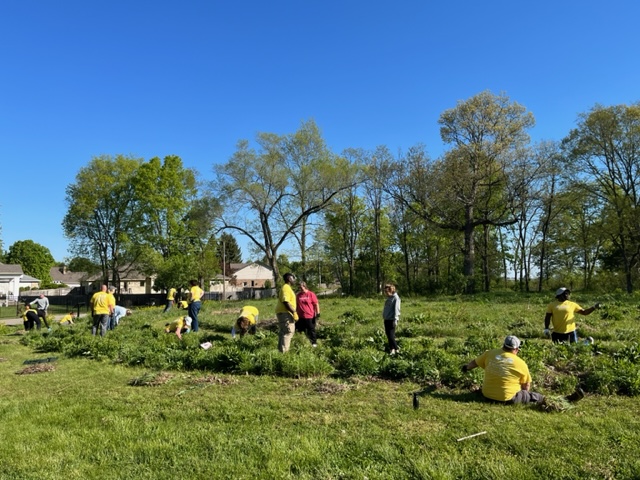
I really enjoy the idea of volunteer work in public spaces. For me, it feels like the basics of civilization. Essentially, I am talking about convincing people that no one needs to get paid to benefit the common good. This is a difficult task on a number of levels.
First, people like to get paid.
Second, there are city and county workers who get paid to maintain public spaces who may not like volunteers working in these same areas.
Third, doing large scale projects to benefit the public good requires money, talent, time, and coordination.
Fourth, if the project is going to endure, maintaining public space designed and created by volunteers requires long term support from people who are paid.
This is even more difficult to achieve when doing landscape projects.
About three years ago, my friend, Ben, and I had just completed a volunteer landscape project and had ambitions for a bigger endeavor. We needed someone who had control over substantial amounts of grass (aka green canvas) and an appreciation for native plants.
We found our key supporter in Brian Payne, Director of the AirPark property on the north side of Columbus. In addition to the acre of land that he had already given us to create a meadow, he also has about a 2 mile People Trail going through his property.
We developed a fundraising campaign for $15,000 to purchase plants, signage, raised beds, and a bench for a project that we dubbed, the “AirPark Pollinator Path.” In year one, we completed the meadow and transformed an 800 square foot AirPark entrance area into a native plant bed.
We had only used about half of our money, so for spring 2023, we decided to take on over 7,000 square feet of space. It was much more than I had dreamed was possible when we started the fundraising campaign.
By the end of April, 15 new beds were completed. Over the course of one of the most incredible weeks of volunteer coordination, led by multiple Sierra Club members, the sod was removed, mulch was added, plants were layed out, holes were dug, flowers and grasses found their new homes, and water topped off the effort. And then a glorious rain fell that Saturday evening after we were done.
One of the new volunteers that came out mentioned that she is getting a Masters in Public Health. She shared with me that she is convinced that taking care of plants improves health. She wants to be able to explore that more in her education.
I told her that I am very confident that horticulture therapy is an effective way of improving physical and mental health. In my opinion, on any list of options that a doctor, therapist, public health official, pastor, or concerned friend may give to someone in need of support for their mental health, working with plants should be top 5.
I do have a broad definition for working with plants! There are lots of actions that I associate with horticulture therapy in my life. Planting, harvesting, cooking, floral arranging, smelling, weeding, watching the insect interactions, pruning, eating raw veggies straight from the ground, picking fruits from the tree, plucking berries from the bush, drying, saving seeds, composting, rubbing fingers on a mint leaf, waving my hand over the top of native grasses….
Imagine all of the things that you can do just on the other side of what you do not control – after germination, that beautiful creative act when the green shoot emerges from seed. That first glimpse of green has a name – radicle. It is in nurturing that life just one small step after the radicle moment that horticulture therapy emerges for me.
So in these beds of columbine, butterfly weed, western sunflower, joe pye weed, penstemon, aster, coreopsis, iron weed, spiderwort, rattlesnake master, wild quinine, prairie drop seed, little blue stem, and coralberry, our friends the bees, butterflies, bugs, bats, and birds will thrive. The fauna will bask in this culinary floral delight. This becomes their ecological home. The honor of shaping this home is deeply therapeutic for me.
My prayer is that you, dear listener, will thrive as your five senses are opened by interacting with plants – as you taste the pear, smell the elderberry, touch the baptisia, hear the wind through blue stem, and see the blazing star. And remember, in flashes of vibrant memory, the connections you have had with creation since your youth. It has always been there. Be there with it.
As we were wrapping up our final day of planting, the volunteers converged on a corner of the People Trail near a 3-way stop. People drove by slowly. Lingered. Walkers and bikers stopped to thank us. Some asked us what we were doing. People wanted to know who we were with… while the reasonable response was to say Sierra Club, I wanted to say, “we are with the plants.”
Slowing down, to smile
Stranger meets unexpected
In the common good
About the Author
Co-creator of Revealing Voices and resident spiritual poet for the podcast, Eric advocates for the development of better mental health through art and environmental stewardship.One comment on “HAIKAST V – Horticulture Therapy”
Comments are closed.

Lovely sharing, Eric